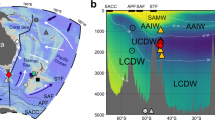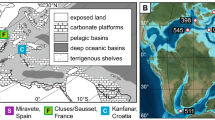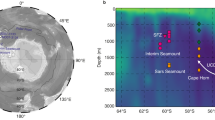Abstract
THE Younger Dryas, an approximately 1,000-year-long return to near-glacial conditions, interrupted the glacial/Holocene climate transition during which most of the Northern Hemisphere ice sheets melted. Evidence for the Younger Dryas event has been found mainly in sediments from the North Atlantic Ocean and northwest Europe, and this has led to the idea that the event was caused by an injection of meltwater into the North Atlantic Ocean1–3. This model, however, has been recently questioned in the light of coral-reef data on the rate of sea level changes during this transition4. Here we present high-resolution oxygen isotope records from benthic and planktonic foraminifera from two radiocarbon-dated cores in the Sulu Sea, showing that the Younger Dry as occurred synchronously in the surface and deep waters of the Sulu Sea and the northern Atlantic Ocean. By combining our results with other palaeoclimate data, we suggest that the Younger Dry as event was a global phenomenon, and we believe it to have been caused by low atmospheric CO2concentrations.
This is a preview of subscription content, access via your institution
Access options
Subscribe to this journal
Receive 51 print issues and online access
$199.00 per year
only $3.90 per issue
Buy this article
- Purchase on Springer Link
- Instant access to full article PDF
Prices may be subject to local taxes which are calculated during checkout
Similar content being viewed by others
References
Broecker, W. S. et al. Paleoceanography 3, 1–19 (1988).
Broecker, W. S. et al. Nature 333, 156–158 (1988).
Overpeck, J. T. et al. Nature 338, 553–557 (1989).
Fairbanks, R. G. Nature 342, 637–642 (1989).
Duplessy, J.-C. et al. Palaeogeogr. Palaeoclimatol. Palaeoecol. 35, 121–144 (1981).
Ruddiman, W. F. & Duplessy, J.-C. Quat. Res. 23, 1–17 (1985).
Berger, W. H. Episodes 8, 163–168 (1985).
Dansgaard, W. et al. Nature 339, 532–534 (1989).
Jansen, E. & Veum, T. Nature 343, 612–616 (1990).
Sarnthein, M. & Tiedemann, R. Paleoceanography 5, 1041–1055 (1990).
Bard, E. et al. Nature 328, 791–794 (1987).
Kennett, J. P. et al. Palaeogeogr. Palaeoclimatol. Palaeoecol. 50, 189–216 (1985).
Wyrtki, K. NAGA-Report No. 2 (Univ. California, La Jolla, 1961).
Quadfasel, D., Kudrass, H. R. & Frische, A. Nature 348, 320–322 (1990).
Linsley, B. K. et al. Mar. Micropaleont. 9, 395–418 (1985).
Vollbrecht, R. & Kudrass, H. R. in Proc. 0DP, Init. Rep. 124 (eds Rangin, C. et al.) 105–111 (Ocean Drilling Program, College Station, 1990).
Exon, N, F. et al. Mar. Geol. 39, 165–195 (1981).
Jelen, K. & Geyh, M. A. Radiocarbon 28, 578–585 (1986).
Wang, L. & Wang, P. Paleoceanography 5, 77–90 (1990).
Linsley, B. K. & Thunell, R. C. Paleoceanography 5, 1025–1039 (1990).
Kallel, N. et al. Oceanolog. Acta 11, 369–375 (1988).
Heusser, C. J. & Rabassa, J. Nature 328, 609–611 (1989).
Pastouret, L. Oceanolog. Acta 1, 217–232 (1985).
Sarnthein, M., Erlenkeuser, H. & Zahn, R. Bull. Inst. Geol. Bassin d' Aquitaine 31, 393–407 (1982).
Duplessy, J.-C. et al. Palaeogeogr. Palaeoclimatol. Palaeoecol. 33, 9–46 (1981).
Dansgaard, W. et al. Science 218, 1273–1277 (1982).
Jouzel, J. et al. Nature 329, 403–408 (1987).
Emiliani, C., Rooth, C. & Stipp, J. J. Earth planet. Sci. Lett. 41, 159–162 (1978).
Jansen, E. & Erlenkeuser, H. Palaeogeogr. Palaeoclimatol. Palaeoecol. 49, 189–206 (1985).
Dean, W. E. et al. Paleoceanography 4, 639–653 (1989).
Barnola, J. M. et al. Nature 329, 408–414 (1987).
Author information
Authors and Affiliations
Rights and permissions
About this article
Cite this article
Kudrass, H., Erlenkeuser, H., Vollbrecht, R. et al. Global nature of the Younger Dryas cooling event inferred from oxygen isotope data from Sulu Sea cores. Nature 349, 406–409 (1991). https://doi.org/10.1038/349406a0
Received:
Accepted:
Issue Date:
DOI: https://doi.org/10.1038/349406a0
This article is cited by
-
A synthesis of paleomonsoon and associated processes from the unique depocenter, Andaman Sea
Geo-Marine Letters (2023)
-
Sediment mass and distribution in the South China Sea since the Oligocene
Science in China Series D: Earth Sciences (2006)
-
Biological records of paleoclimate and paleoenvironment changes from Guanzhong area, Shaanxi Province during the last glacial maximum
Chinese Science Bulletin (2000)
-
Glacial-interglacial changes in the surface water characteristics of the Andaman Sea: Evidence from stable isotopic ratios of planktonic foraminifera
Journal of Earth System Science (2000)
-
Environmental changes recorded in lake sediments for 13 000-1 000 a B. P. in Beijing area
Chinese Science Bulletin (1998)
Comments
By submitting a comment you agree to abide by our Terms and Community Guidelines. If you find something abusive or that does not comply with our terms or guidelines please flag it as inappropriate.



